Making spaces meaningful through architectural storytelling
8 December 2017
The Narrative/Making/Space team reports on their Bartlett doctoral curated event at the Royal Academy of Arts.
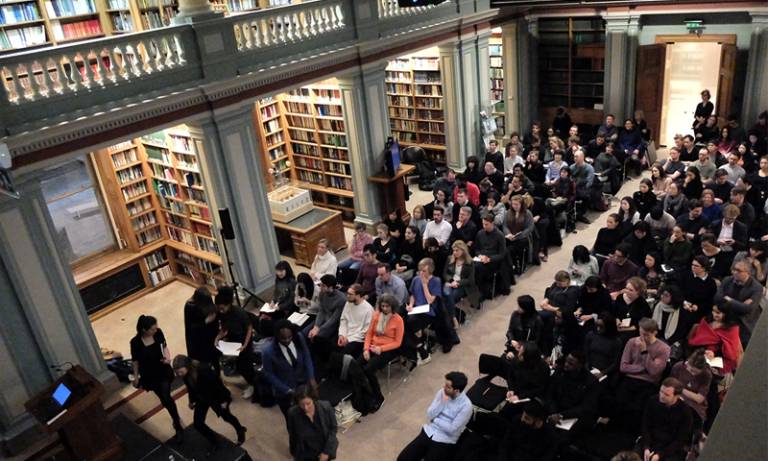
The act of architectural storytelling is crucial to the building of spaces that convey meaningful messages. Within the frame of the idea that the architect storyteller is someone who makes buildings and spaces that speak, in this event we took a closer look at how different narrative media can be used to create new spaces while also altering our understanding of existing ones.
Curated for the Royal Academy of Arts by the PhD programme at the Bartlett School of Architecture, the Narrative/Making/Space event, held on the 27th of November, discussed the relationship between architecture and storytelling. The presentations took place at the adjacent Royal Society of Chemistry; a long open library composed of a series of alcove reading rooms and a mezzanine. Through discussing how the need to ‘make space’ through storytelling seeps into cinema, art installations, and speculative allegorical architectural projects, we counteracted the idea that modern architecture has lost its ability to embody spatial narratives.
The presentations
Thandi Loewenson's research takes the form of a live project: a speculative tender for the Lusaka city dump, being made together with the Lusaka City Council, waste pickers and dealers, which imagines how the dump could be managed by those who currently operate on the site. Through the tender process, she is exploring new methods: how stories told of a fictional city called Mailo can be used to disrupt perceived notions of the city, reinventing it to be discovered again by those who live there.
Acting as a parallel and possible representation of Lusaka developed through drawings and site-specific performances at the dump, Mailo is a test of the possibilities of an architectural interpretation of the literary genre of the New Weird; where politically engaged, urban, ‘secondary world’ fictions are created which draw on real world models and combine elements of science fiction and fantasy. Mailo is represented through large scale graphite drawings which pick up physical traces of the engagement of the waste pickers and dealers with the work, acting as material witness to the process of producing the tender whilst also transferring marks onto those who participate. Props, such as a storytelling mat which is also the flag for the fictional city, act as bridges between a real and a fictional realm.
This physical process of transfer echoes the process of imagining the city; starting with dialogue, followed by drawing, making and then a partial telling of the story allowing the audience to interpret and take the story forward. Through the drawing, making, telling and then interpretation of the fictional space, insights into current practices and possible futures for Lusaka have been revealed. Thandi presented her work through the telling of the story of her project and a subtly animated series of drawings.
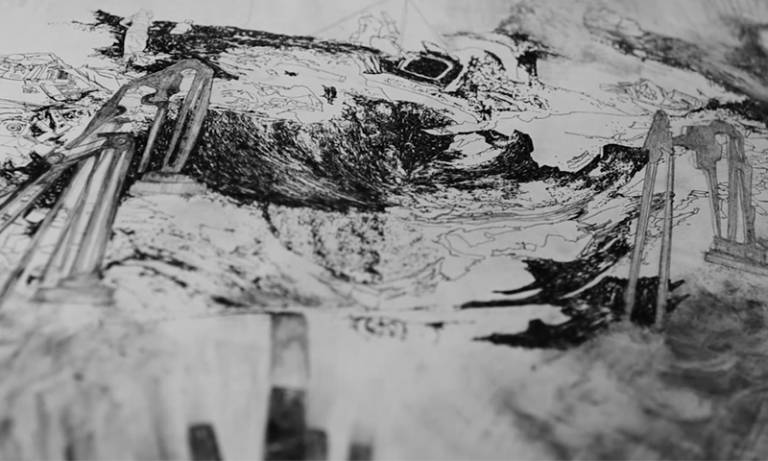
Next up, Catrina Stewart discussed the construction of a hand-made world for the creation of the video game Lumino City. This game was developed through architectural drawings and models which helped with the playful and complex telling of the game's story. A beautiful moment in Catrina's models was a space that rotates 360 degrees, and can work both as a plan and as a section concurrently, which she designed through a series of plans. The game was made to be filmed as a section, and the playfulness of its spaces together with their exquisite detailing, give a sense that this world is a character in itself. Catrina presented the drawings, sketches, and models that she made for the construction of the video game world, together with a film showing the process of filming it as well as the process of combining the analogue spaces and the digital characters.
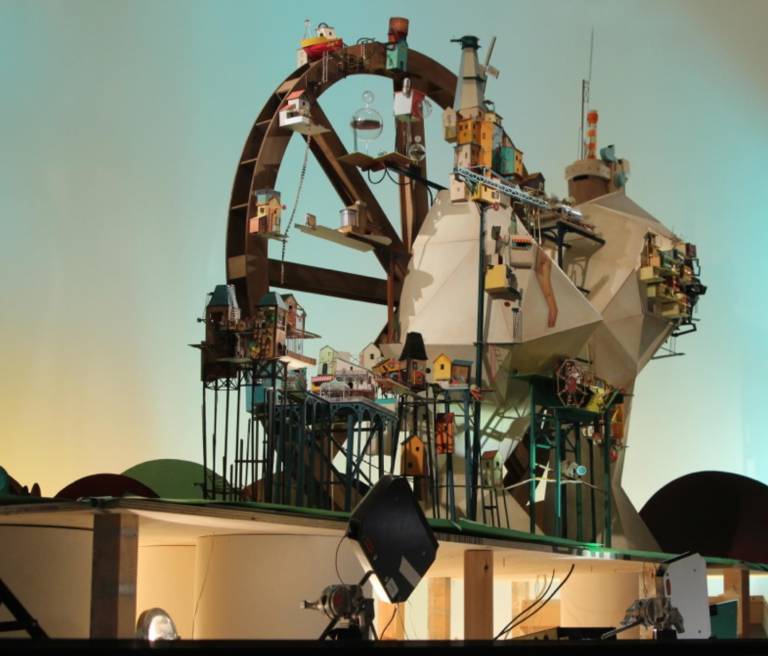
The third contributor Ifi Liangi presented her film, which is the introduction of her novel, a magical realist fairy tale, entitled ‘The Blossomed Bitter-orange Forest’. The writing and animation of her novel is made in the frame of her PhD research, and is in the field of architectural storytelling. One of the driving ideas of her thesis is that our normative world is a dream. This reflects in the idea that the magical realist fairy tale should be the method for the creation of a critical and magical architecture. She says that as a fictional written narrative can tell meaningful stories, so can architecture, which should be able to speak a public language and have a message.
And just as a fictional written narrative cannot tell a story without characters, Ifi is suggesting that a speaking architecture cannot tell a story without a figure. (A figure can be anthropomorphic, or a personified object or an animal.) Her research focuses on Greek architectural storytelling, in Athens, a city in sociopolitical and economic crisis. She is working through a series of translations. From text to text, from text to drawing and model or its reverse, from drawing to model or its reverse, and finally from all three to film. Ifi's film is composed of a series of animated drawings and a variety of characters telling the story under a magical realist soundtrack.
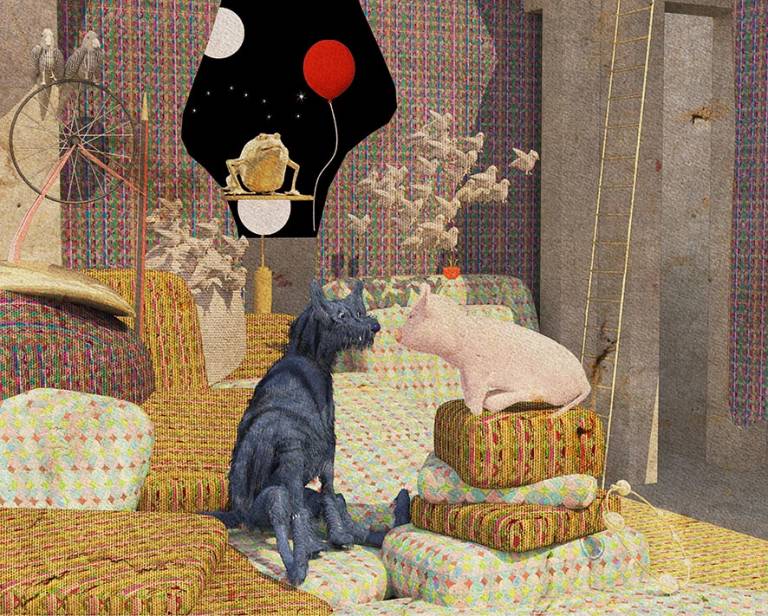
Finally, Kibwe Tavares presented the process of designing the spaces of his films. This is very similar to an architectural design process. He started by discussing the importance of first studying the place where the film is shot, as for example Zanzibar in the case of Jonah. He then went on to describe the careful process of designing the story, involving the making of the spaces and also the characters. In Factory Fifteen, the studio he has co-founded, they work with sketches, drawings, and digital models to explore the designs. Iterations and very careful detailing of the drawings and also the animations are at the heart of their practice. Some of the most architectural moments in Factory Fifteen's work are the shifts on the facades of the buildings, and also the reimagining of a real place's colour, texture, and light.
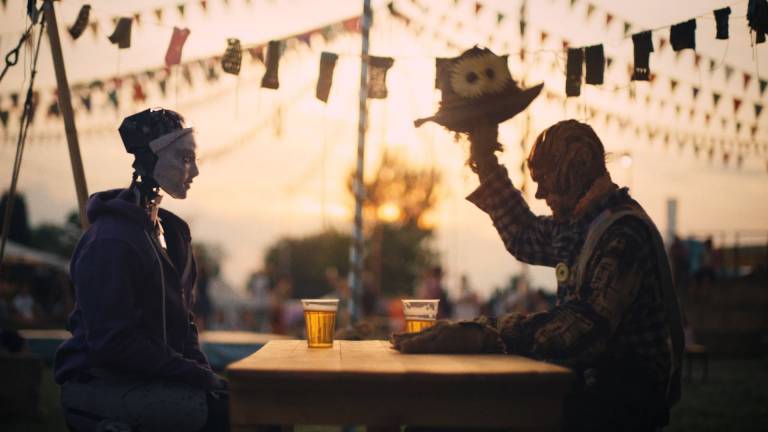
The conversation
Following the presentations, Phuong-Trâm asked a series of questions, relating the different presentations through an engaging conversation.
The first was 'On the transformation of the narrative using different mediums'.
Catrina discussed her intuitive use of hand-made models and her collaboration with animation artists and game designers for the creation of the story for the Lumino City video game. Iterations and sketches over sketches over models were a key part in the process of the creation of the narrative and the transformation didn't stop happening until the combination of the digital and the analogue, where the digital character and analogue lights and atmosphere are combined in unexpected ways.
Ifi talked about her process of first writing her novel and then translating it from Greek to English, which is a process that creates new ideas, as in order to translate the experience of a place one has to describe it. She also talked about the translations from text to drawing and to models, which she is trying to make as a series of interpretations rather than copies, a process that creates more stories through unexpected results because of the translations. These work as creative openings to the next piece.
Thandi said that her narrative shifts continuously as her project develops, being developed by each interaction between the audience-participants, storyteller, paper and graphite. The dialogue between those who engage with the fictional and the material transformation of the drawings through this interaction further contribute to the narrative's transformation.
Kibwe discussed the use of drawing in making the films. Unexpected drawings, such as the section of a fish, or very complex and ambitious drawings, such as the modelling of an entire world, have to be designed in line with the real place where the film is shot, so that the conversations between the two, both visually and intellectually, is believable and critical.
The second question was 'About the tactility of all the work', model, drawing, real characters, and the awakening of the senses, and how important is the relation between the tactile and sensual quality in the work and its digital translation.
Thandi's work is a fascinating example for this answer, as the tactile quality of her work is the essence of it at most times. The animated version of her drawings communicates their material qualities through the soundtrack; the pressure on the paper while engaging with the drawings but also when making them, leave the traces of tactility and bring the observer closer to them.
In Catrina's work, the detailing of the models and their translation to the digital had to be made carefully and at times, in order to keep the game's world visually coherent, it was not possible to do otherwise but in an analogue way; a good example of this was the game's miniature lights, which had to be made by hand.
Ifi suggested that drawing in 3D digitally is useful, but has limits: it is a process where one can find their own ways of synthesising ideas, but at some point it starts becoming stale of unexpected mistakes. Translating to make physical models, the magic of the unexpected comes back. Another important tactile part in her work is smell, which the physical models and drawings communicate more effortlessly than a film.
Kibwe talked about the textures and sounds in his films and how these have to be designed with detail so as to engage the audience emotionally and transport them to the imagined places created.
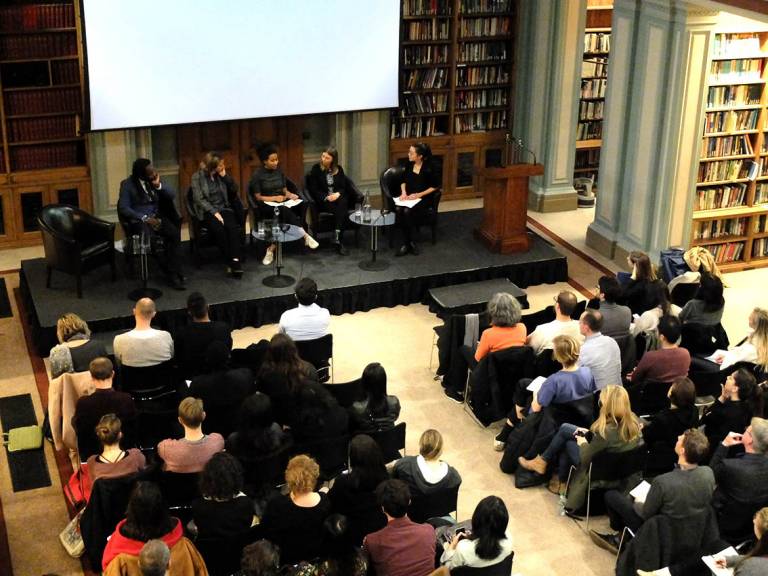
The third question was about the role of playfulness in the work and the use of poetic narratives as a means of referring to concerns about social and cultural issues, as well as the role of characters in the stories.
Ifi discussed the role of magical realism and the classic fairy tale in her work, and more specifically the fact that both magical realism and the classic literary fairy tale were born as means of social critique, at different times and places. In her project, the two narrative modes come together, and allegory, made through language tropes, plays an important role for the communication of the story's ideas. The figurative is one of the vehicles in her novel, which includes thirty six characters, telling stories about the neighbourhood of Kipseli in Athens, both literally and experientially.
In Thandi’s work, characters who originate in the fictional city act as bridges through performance allowing the fictional to become a real presence which can be engaged and debated with in the real. Catrina's models with their long legs and the little huts with the windows and doors that look like characters imply that architecture is alive, while her projects have a subtle environmental narrative.
Kibwe's films also use allegorical techniques and science fiction to discuss current social concerns. The design and making of his characters goes through a process of getting into their shoes: How would that character think? What would they say? Kibwe said that a city can be a character itself, which is a fascinating idea, and also one that weaves the ideas of these four architectural storytellers together. A successful architectural storytelling, a building or a space that speaks, be it drawn, made, filmed, or played, is one that can be read as a character itself.
Credits:
Royal Academy:
Helen Ikla
Organised in collaboration with the doctoral programme at The Bartlett, with (in alphabetical order):
Penelope Haralambidou
Ifigeneia Liangi
Rebecca Loewen
Thi Phuong-Trâm Nguyen
The event was chaired by:
Rebecca Loewen & Thi Phuong-Trâm Nguyen
The speakers were (in order of presenting):
Thandi Loewenson – architectural designer, venture futurist
Catrina Stewart – architect, architectural designer for BAFTA winning video game Lumino City
Ifigeneia Liangi – architectural designer, illustrator, storyteller
Kibwe Tavares – architect, animator and filmmaker; co-founder of Factory Fifteen
The speakers
Thandi Loewenson is an architectural designer and a PhD candidate at the Bartlett School of Architecture. Her research is on the fringes of the real world; operating through design, fiction and performance. In her doctoral research she is exploring the extractive agendas driving the urban development of Lusaka, Zambia. Central to her research is a live project, investigating how insertions of the other worldly and the downright weird can support a community of waste pickers to influence the future of the city dump.
Catrina Stewart is a cofounder and partner at Office S&M, a cross-disciplinary architecture studio based in London. She has previously taught at the Bartlett and now teaches alongside Hugh McEwen at Oxford Brookes University. Her work aims to blur the boundaries between the man made and the digital, driven by the need to express the materiality, colour and richness in the details of the everyday. In 2012 she started a collaboration with State of Play Games, designing and building a hand-made set for a computer game called Lumino City. Amongst other awards, this went on to win a BAFTA for 'Artistic Achievement' as well as being listed as Apple’s top 20 worldwide Apps in 2015.
Ifigeneia Liangi is a PhD candidate at the Bartlett School of Architecture. She is an architectural designer and storyteller. She has been teaching at the Bartlett for three years and is now co-running the Undergraduate Unit 3 with Daniel Wilkinson and tutoring in the second year in the AiS course with Chee-Kit Lai. She has worked in Athens and London based architecture practices and has designed for architecture and exhibition projects in London. She has exhibited her drawings at the Athinais Cultural Center, (2009) and at the Michalis Kakogiannis Foundation, in the frame of the exhibition for the fairy tales of Eugene Trivizas, (2017) in Athens. She has just been commissioned her first theatre set design for a production in Athens, in 2018.
Kibwe Tavares is a co-founder of Factory Fifteen and a Sundance prize-winning film director. He combines his training as an architect with his love of storytelling and animation to create futuristic live action/animated films. He created his film Robots of Brixton during his Master of Architecture at The Bartlett School of Architecture, which won the RIBA Silver President’s Medal in 2011. In 2012 he was cited as one of Fast Company’s ‘100 most creative people in business 2012’ and was awarded a prestigious TED fellowship. He went on to direct the Sundance film Jonah, a stunning combination of live-action and CG shot on location in Zanzibar. In 2014 Kibwe was named as one of the top 20 young directors at the Saatchi & Saatchi New Directors Showcase. His third short film Robot & Scarecrow, starring Jack O’Connell and Holliday Grainger, premiered in the UK this summer.
 Close
Close

